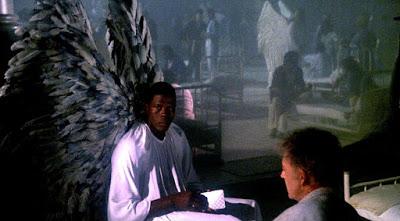Format: DVD from personal collection on laptop.

The Exorcist was one of the most important horror movies ever made. So, naturally, a sequel was planned and made as well. The Exocist II: The Heretic is widely considered one of the worst sequels in film history. It’s the kind of thing that would typically end a series of films. It was that bad. So it’s actually a little surprising that 13 years after the disastrous sequel that a third movie was created. The Exorcist III does exist, though. Fortunately for all involved, it managed to attract no less a star than George C. Scott. It’s also surprisingly good, although nothing close to the original film.
The third film takes place 15 years after Georgetown was plagued by a serial killer known as the Gemini. Lieutenant Kinderman (George C. Scott) worked on the Gemini case in which the victims each had the index finger of his or her right hand removed and the Gemini symbol carved into the left palm. These details were incorrectly leaked to the press to prevent false confessions. Eventually, the Gemini killer was caught and executed. Now, however, a new series of killings is plaguing the town, each following the Gemini killer’s exact pattern, including each victim having a name that begins with a K.
As it happens, it’s 15 years to the day of the events of the original film and the death of Father Karras. On this day, Kinderman meets up with Father Joseph Dyer (Ed Flanders), each convinced that the other needs to be cheered up on that day. The two go to see It’s a Wonderful Life and then talk afterwards, during which Kinderman relates the details of his current case that mirrors the Gemini. That night, a priest is killed, and shortly afterward, Father Dyer winds up in the hospital, and of course ends up dead, also evidently killed by the Gemini killer. He even fits the pattern—his middle name was Kevin. In the current cases, the victims have all had their heads removed. In Father Dyer’s case, all of his blood was removed as well. The worst thing about the case, though, is that none of the fingerprints found at the scenes are the same, indicating different perpetrators.
It’s around this time that Kinderman discovers the existence of a psychiatric ward in the hospital. He learns that there is a patient there who has been locked up for 15 years as a catatonic until recently. This patient, who sometimes looks like Father Damien Karras (and is played in this moments by Jason Miller from the first film) and sometimes looks like the man executed as the Gemini killer (and is played by a manic Brad Dourif), claims to be the Gemini killer and that he will continue to kill.
As Kinderman continues to investigate, he discovers that Patient X, regardless of who he looks like, may have real power. The murders continue, with the death toll at the hospital continuing to rise. Just how the Gemini killer has returned and how he is still committing murders despite being locked in a cell and a straitjacket are mysteries to be solved. But since this is an Exorcist film, it’s not a terrible stretch to guess that we’ll be moving in supernatural circles here.
As I said at the top, there’s no way possible that this could be as good or as important as the first Exorcist film, and it isn’t. It is, however, pretty good. It’s a film that would probably be thought of even more favorably if it had been released with a different name. The book it is based on is called “Legion,” and under that name, it would almost certainly be a better-known and respected film.
It’s also interesting that this was directed by William Peter Blatty, who wrote the book and also wrote the original Exorcist. This was Blatty’s second and final film in the director’s chair, and while there are moments that feel a bit ham-handed, there are some very smart directorial decisions. One of the best is the legendarily good jump scare in one of the hospital scenes. Blatty leaves his camera in one place and lets a scene play out in front of us ending the scene with one of the most genuinely terrifying moments I’ve seen on screen in a good amount of time. It’s incredibly effective.
The biggest problem here is the ending, and it’s the ending that caused the most grief with Blatty himself. Evidently, the ending we get here is nothing like the one from the book and nothing like the one that was originally filmed. It’s not a terrible ending per se, but it feels like it has very little to do with the rest of the film. A character who has only been hinted at in places suddenly becomes critically important, and there’s no reason we can see that he becomes that important. He’s almost a deus ex machina who shows up to save the day. That’s disappointing, and it’s worth noting that it wasn’t Blatty’s fault, but that of the studio.
There’s also a surreal portion where Kinderman is evidently dreaming of the recent victims. For some reason, Patrick Ewing plays the angel of death. And Fabio shows up as an angel as well. I don’t get it. The scene doesn’t really fit in with the rest of the movie, and were it cut, we’d lose nothing.
Still, this is worth a watch. It’s not a great film, but it’s a pretty good one if you don’t mind a slow burn for the first hour or so.
Why to watch The Exorcist III: It’s surprisingly effective.
Why not to watch: Angel Fabio, angel Patrick Ewing.
